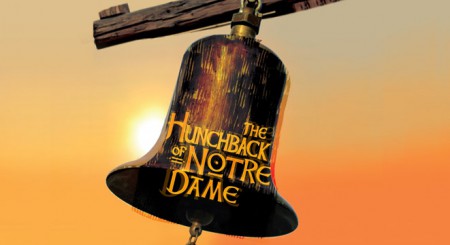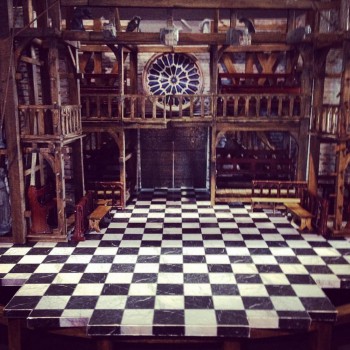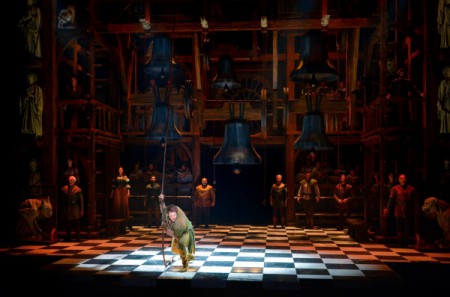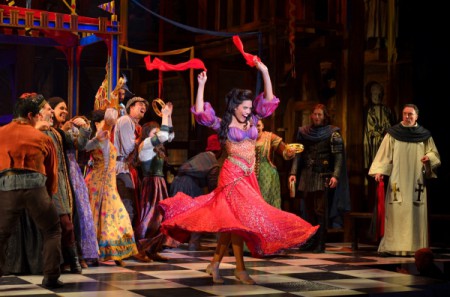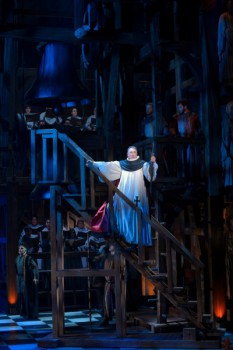Disney Theatrical and Paper Mill Playhouse have partnered together again, finally bringing The Hunchback of Notre Dame to the stage in North America. This team’s previous partnerships included the national tour of High School Musical and the surprise Broadway hit, Newsies, which is about to tour the country. Disney Theatrical first adapted The Hunchback of Notre Dame for the stage in 1999 when it opened in Berlin, Germany (Der Glöckner von Notre Dame) and successfully ran for three years.
Many fans waited for them to bring the show elsewhere, but it existed exclusively in Berlin. The Disney/Paper Mill production is not merely the German show in English. It has a brand new book by Peter Parnell, a new creative team and a different approach to telling the story. It is a mishmash of the Victor Hugo novel and the Disney film, leaning closer to the book than the movie. All of the music is by Alan Menken and Stephen Schwartz, which includes songs from the film, from the German production, and some new songs written for this production. This version debuted at La Jolla Playhouse in San Diego, CA on October 28th, where it is scheduled to run through December 7th. It will then transfer to Paper Mill Playhouse in Millburn, NJ, where it opens on March 4th.
Director Scott Schwartz chose to only use stage techniques that existed at the time the story takes place. Set designer Alexander Dodge created a two-story interior of Notre Dame cathedral on the stage. The entire set is made out of unpainted wood. Rows of pews are set up on either side of both levels and the center of the second floor features a large stained glass window. As it got close to show time, theatergoers began to walk up on stage uninvited. They explored the set, looking around and then walked off stage. It was… odd… and part of me wanted to tell them they’re not supposed to do that. But then they all came back dressed in robes and took their seats in the pews as the choir.
The show began with the amazing choral intro from the film and I believe everybody in the theater had goose bumps at the beginning. Various members of the ensemble took the stage dressed in robes and began to sing “The Bells of Notre Dame,” each taking a different line. This version of the song is longer than in the film with very different lyrics. It gives back-story to Claude Frollo. Orphaned as a boy with his brother, Claude chose to follow the church while his brother Jehan rebelled. He ran off with gypsies and he and his wife died, leaving their deformed baby in the care of Claude, who rose to the status of archdeacon.
Towards the end of the song, actor Michael Arden walked on stage and sang a line as he arched his back, put on a hump and jacket, and smeared dirt on his face to transform into Quasimodo. This was one of many creative choices that I wasn’t thrilled with. His version of Quasimodo has a speech impairment and is much more socially awkward than Tom Hulce’s portrayal in the film. When he sings “Out There,” he bounces back and forth between having the voice of an angel (Arden is a wonderful singer) and having trouble getting his words out. Victor, Hugo and Laverne are absent in this show, but there are talking gargoyles portrayed by members of the ensemble. Each time they speak, they ring a hand bell (why?).
Bells lower from above when a scene takes place in the bell tower and they were really impressive, especially when you realize the orchestra is playing the sounds you hear which are perfectly timed to the clapper hitting the lip. Cloppin, who is a member of the ensemble during “The Bells of Notre Dame,” is introduced to kick off the Feast of Fools with a fun production number for “Topsy Turvey.” A rolling stage is wheeled out for Esmerelda’s dance, a key scene where Quasimodo, Frollo and Phoebus fall in love with her for different reasons.
Ciara Renee plays the gypsy enchantress and is phenomenal in this role. After an incredible performance of “God Help the Outcasts,” during which the window lit up and cast a shadow on the stage, Esmeralda consoles Quasimodo in his bell tower following his public humiliation at the Feast of Fools. The pair sing a song not in the film called “Top of the World,” which was written for the German show.
Andrew Samonsky plays Phoebus, the handsome captain of the guard. I’d seen him once before in the Disney touring production of On the Record and he was a great Phoebus, but I wasn’t thrilled with the changes to the character. He’s still sarcastic, but he’s also extremely horny. During a bar scene, he helps one of his guards hookup with a gypsy while trying to find Esmerelda. Many of his lines contain innuendos and while it’s obvious he has feelings for Esmerelda, it’s hard to think that he’s interested in more than her looks given the dialogue written for him. In “The Tavern Song (Thai Mol Pias),” a number created for this production, Frollo witnesses the sinful lifestyle of the gypsies (and some of the guards) while trying to “save” Esmerelda.
After Quasimodo sings his song about Esmerelda, “Heavan’s Light,” and Frollo sings his, “Hellfire,” comes the finale of Act 1, a song from the German production called “Esmerelda.” It takes place as Frollo is commanding Phoebus to burn the house where Esmerelda is believed to be hiding. All three men sing about the gypsy and how she has turned their lives upside down. It’s the most memorable new song and a fitting addition to the score.
Act 2 begins with a Quasimodo dream sequence where he dreams about Saint Aphrodisius, whom Frollo often talked to Quasi about. It’s a new musical number called “Flight into Egypt” that offered some of the biggest laughs in the entire show. As the story races to a finish, Quasimodo looks after the wounded Phoebus and leads him to the Court of Miracles, where they are followed by Frollo. Esmerelda and Phoebus are captured and she is given an opportunity to live under Frollo’s tutelage if she will give her body to him. She refuses and is sentenced to death, but he gives her one last moment with Phoebus as they sing “Someday,” the end credit song from the film.
As Esmerelda is being burned at the stake, Quasimodo has a moment with the gargoyles in a touching song called “Made of Stone” (from the German show), which is based on the line in the film where Lavern says “We just thought you were made of something stronger.” Quasimodo frees Esmerelda after her stake has been burning and defeats Frollo. Taking the ending from the book, Quasimodo was just a bit too late and Esmerelda doesn’t make it. The show ends with a finale of “The Bells of Notre Dame.” As the song comes to a close, Michael Arden stands perfectly erect and wipes the dirt off his face, getting rid of the hunchback. At the same time, the ensemble hunches their backs and rubs dirt on their faces.
There’s a lot that this production of The Hunchback of Notre Dame does right and its strengths are greater than its weaknesses, but there are a few too many bizarre choices that made it hard for me to fall in love with it. The performances were great, with Patrick Page and Ciara Renee stealing the show as Frollo and Esmerelda. I loved the sets and the theatrics used, such as Quasimodo climbing up the sides of the stage and Cloppin/Esmerelda throwing blasts of smoke to make a getaway. This production is definitely not ready for Broadway, but with some modifications it could be amazing. Aladdin had several off-Broadway productions before they found the right balance, so there is hope for Hunchback. If the MPAA were rating this as a film, it would be PG-13. Toning down the sexuality a bit and adding the trio of gargoyles back in (and the song “A Guy Like You,” which is missing in this production) could make it more suitable for families. I also greatly prefer the film’s ending where Esmerelda lives and walks Quasimodo out into the streets, where he is treated with kindness and respect.

